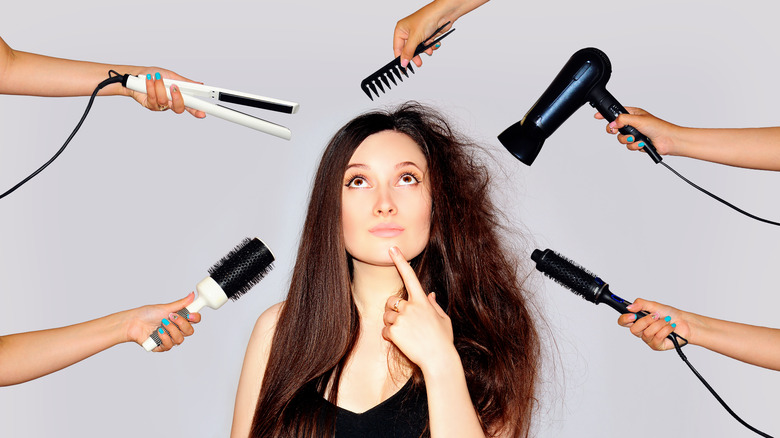New Growth Or Breakage? What Flyaways Can Tell You About Your Hair Health
One day, you might be looking in the mirror, trying to achieve the trendy slicked-back bun, and realize it's not looking so slick. Short hairs that end before your low bun can stick out and frizz. After copious amounts of hairspray and gel, you might either say to yourself, "Wow, it looks like my hair's growing," or, "Oh no, my hair is breaking." Anytime you notice short hairs that stick out, the confusion that comes with it is common.
"Without a trained eye or a microscope, it's difficult to differentiate between short hairs that are broken and short hairs that are growing in," Neil Sadick, a New York City-based dermatologist who specializes in hair growth, told Allure. However, it's not impossible, and there are ways you can determine if your new flyaways are a sign your hair is getting thicker or a sign that it's becoming thinner. By taking a look at your habits and assessing the appearance of your hair, you can find out how to best treat your hair's current state.
How you can tell if it's breakage
Before looking at the quality of these aggravating strands, there are some other behavior-based indicators that these hairs could be due to breakage. You'll want to assess your hair care routine to start. "breakage can be found anywhere on the hair, especially where blonde dye was overprocessed, where hot tools are used repetitively, or where your hair is up in a ponytail or bun constantly," hairstylist Riawna Capri explained to Real Simple.
If you related to that introductory hypothetical, the tight, pulled-back bun very well could be the reason you're bun doesn't look as clean-cut anymore. If you find that a daily part of your styling process involves something known to cause hair damage, it's more likely that this is the root of your issue. "Flyaways that are breakage can have frayed ends that are a different texture than the hair growing from the root," hairstylist Leo Izquierdo told Real Simple.
How you'll know if it's new growth
If your flyaways do not have a thin, unhealthy quality to them and your haircare routine is mindful of mitigating damage, they could be new hairs growing in. "New growth may stick out, but the hair is easier to tame and will cooperate with the style you are trying to achieve," hairstylist Leo Izquierdo told Real Simple. If you're noticing these hairs because they are causing unwanted frizz, unfortunately, it's more likely to be due to damage.
Another way to tell if it's new growth is by looking at how even the shorter hairs compare to one another. "While new hair will generally be in the same growth phase — and thus the same length — damaged hair will vary in length," dermatologist Neil Sadick told Allure.
Whether your biotin or collagen supplements are really creating the hair growth they promised or you need to lay off on the heat applications, the best thing about hair is that it changes over time. If you don't love those little stragglers, give it a month or so of growth or hair repair treatment, and you'll likely see improvements.


